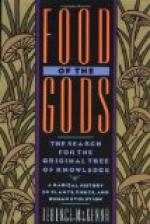“Cocoa is now a commodity to be regarded in our colonies, though at first it was the principal invitation to the peopling of Jamaica, for those walks the Spaniards left behind them there, when we conquered it, produced such prodigious profit with so little trouble that Sir Thomas Modiford and several others set up their rests to grow wealthy therein, and fell to planting much of it, which the Spanish slaves had always foretold would never thrive, and so it happened: for, though it promised fair and throve finely for five or six years, yet still at that age, when so long hopes and cares had been wasted upon it, withered and died away by some unaccountable cause, though they imputed it to a black worm or grub, which they found clinging to its roots.... And did it not almost constantly die before, it would come into perfection in fifteen years’ growth and last till thirty, thereby becoming the most profitable tree in the world, there having been L200 sterling made in one year of an acre of it. But the old trees, being gone by age and few new thriving, as the Spanish negroes foretold, little or none now is produced worthy the care and pains in planting and expecting it. Those slaves gave a superstitious reason for its not thriving, many religious rites being performed at its planting by the Spaniards, which their slaves were not permitted to see. But it is probable that, where a nation as they removed the art of making cochineal and curing vanilloes into their inland provinces, which were the commodities of those islands in the Indians’ time, and forbade the opening of any mines in them for fear some maritime nation might be invited to the conquering of them, so they might, likewise, in their transplanting cocoa from the Caracas and Guatemala, conceal wilfully some secret in its planting from their slaves, lest it might teach them to set up for themselves by being able to produce a commodity of such excellent use for the support of man’s life, with which alone and water some persons have been necessitated to live ten weeks together, without finding the least diminution of health or strength.”
[Illustration—Black and White Plate: Grenada, B.W.I.: Samaritan Estate (Showing trays which slide on rails; the iron covers slide over the whole in case of wet.)]
However valuable this last quality rendered the newly-discovered drink, its method of preparation and the unwonted spices employed prevented its ready adoption abroad, although the Spaniards and Portuguese took to it more kindly than some of the northern races. Joseph Acosta, writing of Mexico and Peru, says:
“The cocoa is a fruite little less than almonds, yet more fatte, the which being roasted hath no ill taste. It is so much esteemed among the Indians (yea, among the Spaniards), that it is one of the richest and the greatest traffickes of New Spain. The chief use of this cocoa is in a drincke which they call chocholate, whereof they make great account, foolishly and without




